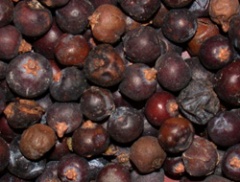Juniper Berries
| Infobox on Juniper Berries | |
|---|---|
| Example of Juniper Berries |  |
| Facts | |
| Origin | - |
| Stowage factor (in m3/t) | - |
| Humidity / moisture | - |
| Ventilation | - |
| Risk factors | See text |
Juniper Berries
Description
AJunipers are coniferous plants in the genus Juniperus of the cypress family Cupressaceae. Depending on taxonomic viewpoint, there are between 50-67 species of juniper, widely distributed throughout the northern hemisphere, from the Arctic, south to tropical Africa in the Old World, and to the mountains of Central America.
Junipers vary in size and shape from tall trees, 20–40 m tall, to columnar or low spreading shrubs with long trailing branches. They are evergreen with needle-like and/or scale-like leaves. They can be either monoecious or dioecious. The female seed cones are very distinctive, with fleshy, fruit-like coalescing scales which fuse together to form a "berry"-like structure, 4–27 mm long, with 1-12 unwinged, hard-shelled seeds. In some species these "berries" are red-brown or orange but in most they are blue; they are often aromatic and can be used as a spice. The seed maturation time varies between species from 6–18 months after pollination. The male cones are similar to those of other Cupressaceae, with 6-20 scales; most shed their pollen in early spring, but some species pollinate in the autumn.
A juniper berry is the female seed cone produced by the various species of junipers. It is not a true berry but a cone with unusually fleshy and merged scales, which give it a berry-like appearance. The cones from a handful of species, especially Juniperus communis, are used as a spice, particularly in European cuisine, and also give gin its distinguishing flavour.
Shipment / Storage / Risk factors
Usually shipped in hessian bags. Used primarily in the manufacture of gin. The berries have a high moisture content and extensive crushing will cause loss in value. Subject to sweating. Storage is recommended in single layer bag levels.











